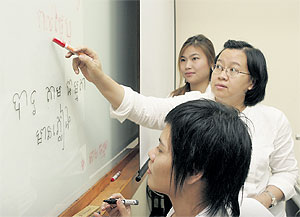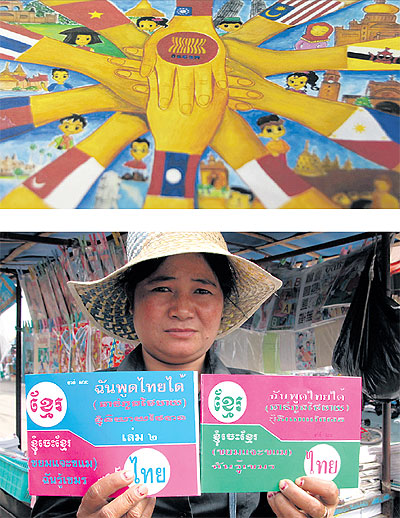Source Bangkok Post - March 11, 2012There has been a great deal said about the need to improve English-language skills ahead of the formation of the Asean Economic Community in 2015, but much less emphasis is put on communication between members in their native languages. While English is indispensable as a common international language, a multilingual approach also has clear advantages for building regional understanding and relations.
According to research released in January by Chulalongkorn University, in addition to English, people in Cambodia, Laos, Vietnam and Myanmar are interested in studying Thai. Many Thais also express interest in learning regional languages to promote cultural understanding.
Consequently, in 2010 the government initiated a multilingual programme in border area schools at the Mathayom (Grade 6-12) level to teach the Lao, Khmer, Myanmar and Vietnamese languages. But a shortage of teachers skilled in these obstacles is preventing the programme from expanding.
Prayoon Songsil, an expert in Khmer and associate professor at Dhonburi Rajabhat University in Thon Buri, expressed concern over the scarcity of programmes at the college and university level geared toward teaching students and training teachers in regional languages, particularly Burmese and Vietnamese.
Students wishing to learn Khmer should have less difficulty, as there are about 20 universities nationwide offering courses.
''We have taught the Khmer language in universities for some time. Therefore we have the resources to accommodate the expected influx of students,''she said.
Ms Prayoon said each university devises the curriculum and sets the duration of its Khmer language programme, with the aim of giving students functional skills and a solid basis for further learning. She said sufficient time must be allowed. ''Three years of intensive study is enough for functional speaking, reading and writing,'' she said. Ms Prayoon initiated the Khmer language course at Dhonburi Rajabhat University about 20 years ago when Cambodia started to reopen after being isolated for years.
''In those days many students couldn't understand why the university was offering courses in Khmer. The courses are optional, but right from the beginning we urged those majoring in Thai to take Khmer courses because the languages have a lot in common and have influenced each other,'' she said.
For many years Ms Prayoon was the only teacher of Khmer at the university. Over time the number of students wishing to study the language gradually increased, and at times limits had to be placed on the number of students accepted into the programme.
The situation has improved because there are now more qualified Thai teachers who can teach Khmer and because of cooperation from universities in Cambodia, which supply teachers for certain periods of time.
Ms Prayoon, 63, studied Khmer and graduated from Silpakorn University.
''Back in those days, people laughed when I told them I was studying Khmer because they couldn't picture how it could be of benefit to my career.'' However, her choice led to job security as more people become interested in learning the language. It has been a labour of love for her. ''Through the language I've learned so much about the country and the people, their culture, beliefs and ways of life,'' she said.
''It is a good trend that people in the cities are becoming more open-minded and wanting to learn more about their neighbours,'' said Ms Prayoon, adding that the Asean Community is an ''important step in understanding each other and living together in peace''.
''People in Cambodia and Laos have for a long time listened to Thai radio programmes and watched Thai television programmes, but Thai people, apart from those living along the border, do not open their minds to learn from them. We do not know them.''
Ms Prayoon is also interested in helping language students on the other side of the Thai-Khmer border.
She explained that both Phnom Penh University and Meanchey University in Sisophon province offer Thai classes.
''In Phnom Penh there are about 80 students taking Thai courses at different levels,'' said Ms Prayoon. ''Meanchey University has offered Thai language courses as a major programme of study for three years now.'' However, there is a shortage of language teachers in Cambodia as well as here.
''My university has entered into a memorandum of understanding for an exchange of teachers, but our teachers are fully occupied,'' she said. A Thai teacher was finally sent to teach Thai literature, but for three months only.
''At Meanchey University, besides offering Thai classes to students, they also want their staff to to speak, read and write Thai. This proves that our neighbours have a curiosity about us,'' she said.
However, said Ms Prayoon, the political and military conflicts between the two countries in recent years have hampered cooperation. Some Thai teachers contemplating working in Cambodia have opted to teach in China or Vietnam instead. Safety remains an important consideration, although the bilateral situation has improved considerably of late.
CROSS-BORDER COOPERATION
Meanwhile, regional cooperation is quite good in the few border area schools involved in the government's multilingual programme at the Mathayom level. Boonruang Kajama, a teacher at Prasatvittaya School in Surin province said that his school doesn't have any shortage of teachers for its language courses.
Prasatvittaya is one of four schools in the country offering multilingual programmes. The other schools are in Si Sa Ket, Chiang Rai and Tak, all border provinces.
Prasatvittaya School offers students in Mathayom 1 to 6 classes in Lao, Burmese, Khmer and Vietnamese, as well as English.
''We have teachers from Laos and Cambodia to teach our students. The school has networks with those countries for personnel exchange. Our teachers of Vietnamese are Thai who are trained in the language,''said Mr Boonruang. He added that in Surin province many locals speak Lao or Khmer dialects at home, so it is much easier for students to pick up these languages, reading and writing as well as speaking.
Mr Boonruang said most everyone agrees that students should learn English, but some parents have difficulty accepting that their children should learn the languages of neighbouring countries. This is especially true when proficiency in a particular language is not valued within the community and the parents do not think that it will help their children in their future careers.
But Mr Boonruang said this attitude is changing. The school has campaigned to promote the importance of the coming Asean Community and explain why students should be encouraged to study regional languages. Both students and parent have a better understanding now, he said.
In 2010, there were 25 students enrolled in the multilingual programme. Last year this increased to 62 students.
Students learning Khmer went to Siem Reap in Cambodia to practise the language and learn about the lives of the locals, and there was a similar cross-border trip for students learning Lao.
''Learning foreign languages is not difficult for children,'' said Mr Boonruang. ''Early language training makes them fluent, especially when it's a language their parents or other members of the community already use in daily life.
''If we people in Asean countries can communicate among ourselves in our own languages, we will become closer. It will help reduce conflicts. We already share many religious and cultural beliefs.''
Supamas Tevadithep, a teacher at the multilingual Mae Sai Prasittisart School in Chiang Rai's Mae Sai district, said her school has offered classes in Burmese for 10 years, long before the government initiated the multilingual programme in 2010.
The school also has classes in Chinese. In the bustling border trading town many residents speak Thai, Burmese and also Chinese.
''Most people in Mae Sai can speak or understand Burmese to an extent,'' said Ms Supamas, and this is a big advantage when it comes to teaching children as well as adults.
So far the school has not faced a shortage of either Burmese or Chinese teachers.
''We have qualified native speakers to teach our students. Moreover, we have close contacts with Rangoon University, which from time to time sends staff to provide extra lessons to the students,'' said Ms Supamas.




No comments:
Post a Comment